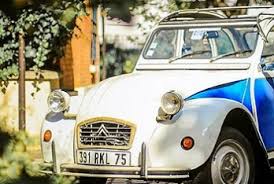 The Defence force spends somewhere in the region of $40m a year in recruitment of men and women to the army, navy and air force. Nowhere in the advertisements is the message, join the defence force to be killed fighting for your country. Rather, learn skills, enjoy yourself.
The Defence force spends somewhere in the region of $40m a year in recruitment of men and women to the army, navy and air force. Nowhere in the advertisements is the message, join the defence force to be killed fighting for your country. Rather, learn skills, enjoy yourself.
So why would a young doctor go into general practice when there is so much moaning in the background about how terrible general practice is. When I was young, I remember “Country Practice”, a TV show which extolled the virtues of general practice. Since then there have been TV doctors featured as dysfunctional, exiled to the country, as for instance in “Doctor, Doctor”. The portrayal involved a great amount of sordid activity. The characters were hardly appropriate role models, but when you watch an optimistic sitcom such as “Call the Midwife”, one wonders how that would play out if moved from an inner London setting to the Australian outback.
I was involved in rural health until about five to six years ago. I have seen very clearly what works and what doesn’t; and it distresses me to see the same suggested solutions rolled out, knowing they have failed previously. One is this bleating about how difficult it all is; and their need for more doctors. Then when a doctor is suggested to join some of these doctors in apparent need, some back away worrying that their income will be impaired.
Then I wrote about the challenges, which I have observed over the years; I doubt whether they have changed. They seem not to have been taken into account in the platitudes in the latest 12 page report supervised by the Minister, who unfortunately seems to have been captured by these purveyors of stuff that does not work. The challenges to rural practice are:
- social dislocation
- professional isolation
- community tolerance
- succession planning
Social dislocation is encapsulated in the reluctance of one’s partner to relocate and where the doctor needs to send his/her children away to school. Professional isolation exists in a variety of ways – working on one’s own so that one is effectively rostered on duty 24/7, without locum relief or where one refuses to share on-call with doctors in other practices. I have worked in small communities with hospitals; and well managed they provide an essential resource in enabling work with other health professionals where there are not enough doctors.
Community tolerance is thus at the heart of the inter-relationship with other health professionals and the community. The idea that health professionals will automatically work together, by some magical wafting of a bureaucratic report, is fanciful. Strength of leadership and an ability of the doctor to work in the community needs someone who automatically is expected to join a community and its activity. When there is an immediate barrier of language and customs, not to mention personality traits, expectations may not be fulfilled. Some doctors are not joiners, they do not want to become involved in social activities. Added to this, some doctors need to adjust to the fact that unlike the city, there is no anonymity; one common reaction is to leave the community over a weekend “just to get away”.
Then there is the most important challenge and that is succession planning. Few practices do it, but the ones that do are successful because they promote continuity in service and hence corporate memory and trust among their patients. There should be a rule of thumb that if one survives the initial period, then one should guarantee (and be guaranteed) a certain length of time in one practice. Five years seems to be reasonable in this modern age, where there is fluidity in employment among health professionals. That means that once the number of doctors needed to provide the best possible service is settled, then one works to maintain that level, remembering that what attracts doctors is a functional practice which, implicitly or explicitly, has paid attention to the top three challenges I have listed.
Income is always important, but it is not a specific condition for general practice and the whole matter of Medicare will be dealt with in my next blog.
I have written about rural medical practice endlessly, (my previous blogs attest to this) but the underlying problem is that the bureaucrat writes the report as if the work has been completed. In reality it is only the beginning, because implementation is always the difficult part.
Once they genuflected and cried: Go to Pell
Many shameful episodes in Australian politics in recent years, but hard to think of a lower moment than seeing two former Prime Ministers attend the funeral of a cardinal who covered up institutionalised sexual abuse of children and protected paedophile priests – Twitter comment
My eye was attracted to this comment about Cardinal Pell’s funeral. I have a relative who played football with the young George Pell when he was a journeyman country Australian footballer, a big man (195cm) who shouldered some of the ruck load. My relative was adamant that Pell would never have been a child abuser.
The problem is that Pell did have “form” from his time as a young priest, was criticised by the Royal Commission into Child Abuse, was convicted and imprisoned, and the conviction overturned on technical grounds which did not clear Pell, but the decision indicated that High Court was not convinced that the matter of reasonable doubt had been addressed satisfactorily. The evidence of a monsignor seemed to be believed above the evidence of others, without any real evidence of the veracity of his recall of the circumstances of the accusations made against Pell.
After Pell disappeared to Rome, the Sydney diocese must have started planning for his inevitable death. It was such a highly staged spectacle, seemingly having every Roman Catholic priest recruited for the ceremonial requiem mass. It also seems that the Sydney diocese has decided not to go with the shift in the political winds in Rome, even with the current ailing Argentinian pope, and to combat the progressives who are on the rise. Sydney may decide to become the home of such Roman Catholicism – refusing to consider contraception, abortion, celibacy, the ordination of women, vaccination against cervical cancer and even encouraging the re-introduction of the Tridentine mass (currently four churches in Sydney).
To airbrush Pell is a common trait in Australian culture – turning a scumbag like Ned Kelly into a national hero is another example. Tony Abbott ‘s extravagant comment does not do the situation justice. Abbott is not rabid, in that he has not presumably been bitten by a dog, squirrel or civet. His statement that those outside the cathedral yelling “Pell go to Hell” meant they at least believed in the afterlife and thus this was the first verified Pell Miracle (gained him a few cheap tweets) but was just plain stupid.
The Church cannot be serious about canonisation of a man who has been shown to facilitate, indirectly or directly, sexual molestation of children by a collection of priest predators, some of whom were close to him at some point. Since Peter became the first Bishop of Rome, the Church has survived a great deal of malfeasance, and perhaps this will continue to persist.
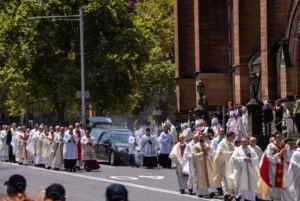 The other perception of the Church is how ludicrous some of the regalia looks when placed alongside stated conservative attitudes. After all, look at the fancy dress of the church dignitaries and then fast forward to the forthcoming dress-ups for mardi gras by the queer dignitaries.
The other perception of the Church is how ludicrous some of the regalia looks when placed alongside stated conservative attitudes. After all, look at the fancy dress of the church dignitaries and then fast forward to the forthcoming dress-ups for mardi gras by the queer dignitaries.
And the other intriguing question, will Abbott and his seminarian mates have to wait for a new Pope to get an Australian Cardinal – or will there be a progressive addition to the Curia gifted by Pope Francis? And could he reach beyond the current list of bishops to perhaps a priest of principle, a man with a progressive tinge.
My Country, Ngangkari
It was one of those times when I was in Ernabella, and I was introduced to a young man, who I was told was a ngangkari. Ngangkari is a Western desert name for the medicine man. In every community I understood that there were these people, not necessarily men, who were responsible for the spiritual totems. I became aware of this fact when there was talk of a kadaitcha man when I was working in western NSW in the 90s. Although he was never identified, I was assured that he existed, right down to the feathered feet not leaving footprints. Before this can be dismissed as myth, I wonder if, in the construction of the Voice, whether these medicine men were consulted. Do they still exist, because it is important for the integrity of the Aboriginal traditions given the fragility of oral traditions; to assure the continuity of the spiritual values of each particular tribe.
As I said, at Ernabella I was introduced to a young man, who had been identified as a ngangkari. Like many Aboriginals, he was taciturn, especially confronted by a whitefella “blow-in”. What attracted me to him were his luminous indigo eyes. I was looking into the 40,000 or whatever years of Aboriginal heritage. I tried many approaches to engage him, and the one that worked was when I said “Adelaide Crows”. He broke into a wide smile, and the indigo eyes glinted into the twentieth century. For me, it was important to know that the medicine man existed; it was not for me to interrogate him. He was non-committal in describing his role; but what I knew was how important the oral tradition was to the medicine man/woman and the secrets that had been passed onto this man. By responding to Adelaide Crows meant that this ngangkeri was not set apart from modern life.
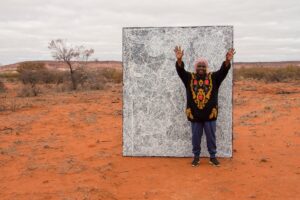
The question arises as to where these medicine men and women have been included in defining such an ephemeral notion as the Voice, because so much of the tradition included in the Voice is embodied in oral tradition. This handed down from one generation of medicine man/woman to the next would seem to be more important than a bunch of Aboriginal academics with confected lines, none of which are incorporated in oral tradition that have been lost or remain as an imagined thread.
I just hope that Voice is not an exercise, a grab for power, by some clever Aboriginals without any real links to the oral discourse. It is as if in the same way I would invoke my Irish ancestors in justifying an Irish voice in how Australia is run. In the end so-called “recognition” could be extended to being an implicit right of veto over legislation, as interpreted by a sympathetic High Court so that the end result is a third chamber of parliament in Australia, with all the complications that would bring.
The ongoing judicial interpretation of something as broadly worded as seems to be proposed by the referendum is likely to cause headaches, since Aboriginality may become of one of judicial interpretation. The legal consequences of a successful referendum will move slowly. Without the involvement of those such as the medicine men or women who carry the Aboriginal lore, it is in danger of becoming the plaything of that band of academic Aboriginals, and of course Noel Pearson. I do not have to worry about the unexpected consequences of all this political malarkey which threatens to consume the country’s political life this year, but my grandchildren may.
Our Bicentenary
I was amazed to see how the mangroves are flourishing around Iron Cove in inner west Sydney. The past three years have meant that I have spent little time in a place where, 30 years and more ago, I used to run to maintain fitness. The Iron Bay run is 7 km, and relatively flat. Nevertheless, the run includes a number of microclimates, which make it an interesting route. The problem with Iron Cove, which is one of the estuarine inlets of the Parramatta River, is that it has experienced two centuries of whitefella pollution. One of the major pollutants has been dioxan, and therefore I would never intentionally eat fish or crustacea from the Cove. But others do.
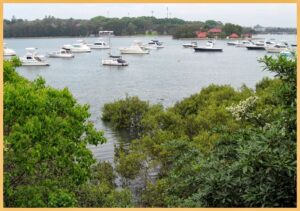 When I used to run the Iron Cove, the mangroves were there, but not to the height and extent as the mangrove forest now. It used to be stunted and did not exhibit its current lushness – rather it was a swamp bordering on the estuary, the water flowing tidally, and at ebbtide, it was a muddy swamp with just a thin cover of mangroves. Now it is different and given the mangrove so essential for water hygiene, maybe the underlying pollution will diminish.
When I used to run the Iron Cove, the mangroves were there, but not to the height and extent as the mangrove forest now. It used to be stunted and did not exhibit its current lushness – rather it was a swamp bordering on the estuary, the water flowing tidally, and at ebbtide, it was a muddy swamp with just a thin cover of mangroves. Now it is different and given the mangrove so essential for water hygiene, maybe the underlying pollution will diminish.
After all, the Parramatta River which is estuarine for a considerable way contains numerous diverticular inlets to enhance its presence and importance. If there had not been such a river, the original settlement would not have survived because the soil around the harbour is poor and shallow on the underpinning sandstone. Gardening in suburban Balmain attests to the need to improve the soil and not dig too deep. The Parramatta River was a gateway to its upper reaches where cereal crops could be grown. In other words, here was the arable land,
In recognition of its importance, to celebrate the Bicentenary in 1988, we ran the Parramatta River from Long Nose Point as far as we could to Parramatta and to where the Toongabbie Creek flowed into it.
Like the mangroves, there has been a cleansing of the Parramatta River and its banks. This has been done without interfering with historic buildings built in the early years of the colony. Then many of the buildings were fenced off and left to rot because they were deemed too expensive to renovate. A large chunk of land with a 220 metre frontage on the Parramatta river was given over to the Department of Defence Naval Stores depot at Ermington, fenced off and like so much of the littoral lands unavailable to public access. In some parts, the other side of the river was available. But there was still a great deal of industrial land to be negotiated, for instance running through the coal dust and railway lines at Camilla. The skun dog carcase added to the sights as we padded along the riverside pathway nearing Parramatta one Sunday.
In 1988, it was an unloved waterway – the industrial sewer, yet with these marvellous sandstone Georgian buildings boarded up; fenced off – then too expensive to renovate. To us, just running it was our tribute to 200 years of European migrant population
Now 44 years later, the NSW Government has announced that it will put $60 million towards the pathway, which has been dubbed the Parramatta to Sydney Foreshore Link, a 91 kilometre path able to be used by both pedestrians and cyclists. It will start by the Harbour and end at Parramatta Park. “In the process, it’ll become one of the city’s longest transport connections, spanning a whopping 18 suburbs,” boasts the media release.
So, there you go, it took us several Sundays to run the distance. We had to make various compromises because the foreshore was unavailable; but what it said to us about 1788, there were many resourceful people who for better or for worse brought their civilisation to this huge continent. While we have despoiled, we have avoided building a country torn apart by waves of invaders battling over territory, because the Australian continent was ignored until the end of the eighteenth century except by a few, who left alone for thousand of years developed a most intricate culture among a remarkably diverse “nation”, yet which needed only one group of invaders to almost destroy it. But then again, Australia could have been colonised like Africa, and then the Continent would have been properly shredded.
How to deal with a Pomegranate
Obviously, pomegranate seed mining presents a problem for Americans, as suggested by this article in the Washington Post. An example of tough love?
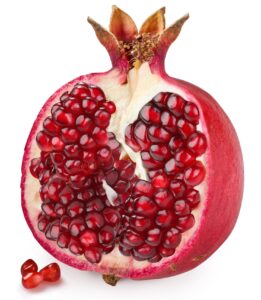
Cut the pomegranate in half through the equator, hold a half cut side down in your hand over a dish or bowl and whack it — firmly, confidently — with a wooden spoon.
That’s it. Just make sure you’re hitting the fruit with the underside of the bowl of the spoon, rather than the edge, which is more likely to crack it. If you want to be a little extra, you can roll the fruit around on your counter before cutting to help loosen the seeds, though I didn’t bother. If you’re worried about splatters, use the biggest, widest bowl you have. (don’t do this while wearing white.)
It took me a less than two minutes per half to remove all the seeds, no prying required. Just periodically turn the halves over to see where you need to focus your efforts to ensure all the seeds come out. Very little of the membrane or white flesh ended up in the bowl, and whatever did was easily picked out. If I shook the bowl like I was tossing a salad, the extra bits rose to the top or spun to the edges, making it even simpler, no water needed. After that, it was easy to transfer the seeds to an airtight container in the refrigerator, where they should be good for at least five days, though I’ve pushed it longer. If you want to freeze the seeds for a few months, be sure to place them in a single layer on a lined baking sheet and then pack them in a bag or container once they’re froze.
This simplicity of this method was in stark contrast to the more photogenic technique that infiltrated my Instagram feed, in which you carve out the top and then try to cut the pomegranates into its naturally occurring segments. It took me way longer to do this, as I still had to press and pry out the seeds. Plus, surprisingly, it sent more seeds onto the floor than the whack-it-over-a-bowl method.
As an added bonus, the wooden spoon strategy is incredibly therapeutic. Whack out your frustrations, and then enjoy the fruits of your labour. Win-win.
Mouse Whisper
As he says, his pronunciation leaves something to be desired. Thus, when he pronounced his Citroen as a “Citron”, he wondered why it did not sell, until he was placed in the front of a mirror and given an elocution lesson.

